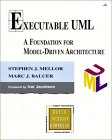 |
|---|
| Overview |
| Contents |
| FAQ |
| Authors |
| Register Your Copy |
| Discuss the Book on Yahoo Groups |
| Get the Models |
| Book Bugs |
Contents
|
Chapter 1
Introduction |
Raising the Level of Abstraction • Executable UML • Making UML Executable • Model Compilers • Model-Driven Architecture |
|---|---|
|
Chapter 2
Using Executable UML |
The System Model • Modeling a Single Domain • Verification and Execution • The Big Picture |
|
Chapter 3
Domains and Bridges |
Domains • Domains and Requirements • Bridges • Aspects and Join Points • Domains and Aspects |
|
Chapter 4
Use Cases |
Basics of Use Cases • Working with Use Cases • Activity Diagrams • Formalizing Use Cases • Scenarios and Testing |
|
Chapter 5
Classes and Attributes |
Classes • Attributes • Attribute Data Types • Documenting Classes and Attributes • Checking Classes and Attributes • Rules, Rules, Rules |
|
Chapter 6
Relationships and Associations |
Associations • Association Descriptions • Checking Associations • Association Classes • Generalization and Specialization • Reflexive Associations • The Class Model |
|
Chapter 7
Class Actions |
Object and Attribute Actions • Selection Expressions • Link Actions • Link Object Actions • Generalization Hierarchies • Other Action Languages |
|
Chapter 8
Constraints |
Unique Instance Constraints • Derived Attributes • Referential Constraints • Association Loops • Constraints Capture Semantics |
|
Chapter 9
Lifecycles |
Concept of a Lifecycle • State Machine • State Transition Table • Creating and Deleting Objects Forming Lifecycles • Lifecycles for Classes |
|
Chapter 10
Communicating Objects |
Signals • Creating and Deleting Objects • Visualizing Domain Dynamics • Domain Dynamics |
|
Chapter 11
Synchronizing Objects |
How to Think About Time • Rules about Signals • Rules about Procedures • Rules about Data Access • Delayed Signals and Time Events • Rules, Rules, Rules |
|
Chapter 12
Using Lifecycles |
Statechart Diagram Construction Techniques • Reworking the Class Diagram |
|
Chapter 13
Relationship Dynamics |
Dynamically Simple Associations • Associations Involving Competition • Dynamics in Generalization Hierarchies Polymorphic Events and Polymorphic Signals • Reclassification |
|
Chapter 14
Domain Dynamics |
Partitioning Control • Control Strategies • Delegation of Control • Input Conditioning • Distributed Dynamics |
|
Chapter 15
Domain Verification |
Finding Unit Tests
for a Single Use Case • Test Execution • System Tests • Finding Test Cases
from the Models • The Verification Gap |
|
Chapter 16
Model Management |
Dividing Large Domains • Subsystems and the Class Diagram • Collaborations between Subsystems • Adjusting Subsystem Partitioning • Model Management |
|
Chapter 17
Joining Multiple Domains |
Kinds of Domains • Anonymous Explicit Bridges • Implicit Bridges with Join Points • Bridging to the Model Compiler |
|
Chapter 18
Model Compilers |
Completing the Models • Model Compilers and the Software Platform • Fit • Buying, Modifying, and Building a Model Compiler • Modeling the Model Compiler as a Domain |